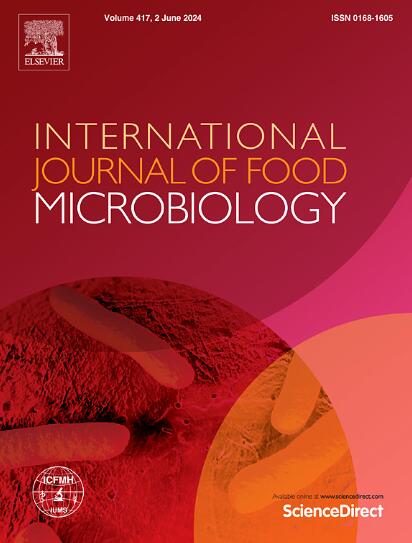DNA metabarcoding for the identification and relative abundance assessment of general and potentially pathogenic bacteria in Sardinian sheep cheese processing environments
IF 5.2
1区 农林科学
Q1 FOOD SCIENCE & TECHNOLOGY
International journal of food microbiology
Pub Date : 2025-07-16
DOI:10.1016/j.ijfoodmicro.2025.111353
引用次数: 0
Abstract
In dairy processing facilities, microbial contamination poses significant challenges to food safety and quality, even under rigorous hygiene protocols as those implemented in sheep milk processing in Sardinia. Specific niches within factories facilitate the persistence of spoilage and pathogenic microorganisms, including Listeria monocytogenes, Salmonella spp., Bacillus cereus, and Pseudomonas spp. Hereby, 16S rRNA-based bacterial metabarcoding was applied to assess bacterial populations in Sardinian cheese processing environments. The scope was to acquire taxonomical information on the total microbiota, including the presence of taxa known to feature also potentially pathogenic strains. Samples were collected from 14 dairy plants distributed throughout Sardinia, analyzing nine areas of the cheese processing line and their workflow pieces, distinguishing food-contact from non-food-contact surfaces, for a total of 253 samples. Five sequencing runs yielded 51,114,952 quality-filtered reads, resulting, upon bioinformatic processing, in 4426 annotated taxonomic lineages. A clear community partition driver within the technical workflow, was identified upon grouping the areas of washing-processing apart from those of salting-aging-shelving. Notably, the genus Halomonas and the family Halomonadaceae dominated and differentiated the microbial composition across samples. Sequences which belong to potential pathogens were instead prevailingly in the opposite sites when compared to salt-adapted biota.
DNA元条形码技术用于撒丁岛羊奶酪加工环境中一般细菌和潜在致病菌的鉴定和相对丰度评估
在乳制品加工设施中,微生物污染对食品安全和质量构成了重大挑战,即使在撒丁岛羊奶加工中实施了严格的卫生规程。工厂内特定的生态位有利于腐败和致病微生物的持续存在,包括单核细胞增生李斯特菌、沙门氏菌、蜡样芽孢杆菌和假单胞菌。因此,基于16S rrna的细菌元条形码应用于撒丁岛奶酪加工环境中的细菌种群。其范围是获取总微生物群的分类信息,包括已知具有潜在致病菌株的分类群的存在。样本来自撒丁岛分布的14家乳制品厂,分析了奶酪加工生产线的9个区域及其工作流程,区分了食物接触和非食物接触的表面,总共253个样本。五次测序运行产生了51,114,952个高质量过滤的读数,经过生物信息学处理,得到了4426个注释的分类谱系。在技术工作流程中,一个明确的社区分区驱动程序,在将洗涤处理区域与盐化老化货架区域分组后被确定。值得注意的是,盐单胞菌属和盐单胞菌科在不同样品的微生物组成中占主导地位。与适应盐的生物群相比,属于潜在病原体的序列主要位于相反的位置。
本文章由计算机程序翻译,如有差异,请以英文原文为准。
求助全文
约1分钟内获得全文
求助全文
来源期刊
CiteScore
10.40
自引率
5.60%
发文量
322
审稿时长
65 days
期刊介绍:
The International Journal of Food Microbiology publishes papers dealing with all aspects of food microbiology. Articles must present information that is novel, has high impact and interest, and is of high scientific quality. They should provide scientific or technological advancement in the specific field of interest of the journal and enhance its strong international reputation. Preliminary or confirmatory results as well as contributions not strictly related to food microbiology will not be considered for publication.

 求助内容:
求助内容: 应助结果提醒方式:
应助结果提醒方式:


